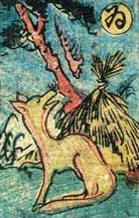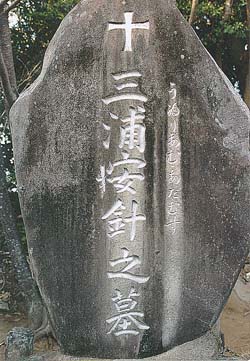ヰ on:
[Wikipedia]
[Google]
[Amazon]
(: , : ) is a nearly-obsolete Japanese (Japanese phonetic characters, each of which represents one mora). The combination of a W-column kana letter with in was introduced to represent iin the 19th century and 20th century. It is presumed that represented , and that and represented distinct pronunciations before merging to some time between the Kamakura and Taishō periods. Along with the for ( in , in ), this was deemed obsolete in Japanese with the orthographic reforms of 1946, to be replaced by in all contexts. It is now rare in everyday usage; in

 In the
In the
onomatopoeia
Onomatopoeia is the process of creating a word that phonetically imitates, resembles, or suggests the sound that it describes. Such a word itself is also called an onomatopoeia. Common onomatopoeias include animal noises such as ''oink'', '' ...
and foreign words, the form (U- mall-i is preferred.
The still sees some modern-day usage, however. The spelling of whisky
Whisky or whiskey is a type of distilled alcoholic beverage made from fermented grain mash. Various grains (which may be malted) are used for different varieties, including barley, corn, rye, and wheat. Whisky is typically aged in wooden ca ...
is usually , but is sometimes written stylistically, such as . The name of the comedy duo Yoiko is written , a character in the video game series '' Touhou Project'' has the name (Tewi) and the first opening theme to the Future Diary
is a Japanese manga series written and illustrated by Sakae Esuno. It was serialized in Kadokawa Shoten's '' Shōnen Ace'' between January 2006 and December 2010, and has been collected into 12 ''tankōbon'' volumes. The plot depicts the Dia ...
anime series is titled (Kuusou Mesorogiwi). The is sometimes written with a , , to represent a sound in foreign words; however, most IMEs lack a convenient way to do this. It is far more common for /vi/ to be represented by the combination .
is still used in one of the Okinawan orthographies, New Okinawan, for the syllable and in digraphs for . In the Ryukyu University system, the is used for , while is . The is also used in Ainu for .
History
Nara period (710 – 794 AD)
During theNara period
The of the history of Japan covers the years from CE 710 to 794. Empress Genmei established the capital of Heijō-kyō (present-day Nara). Except for a five-year period (740–745), when the capital was briefly moved again, it remained the c ...
, ヰ was pronounced as iand イ as In the Man'yōgana
is an ancient writing system that uses Chinese characters to represent the Japanese language. It was the first known kana system to be developed as a means to represent the Japanese language phonetically. The date of the earliest usage of thi ...
, there were characters to represent ヰ (e.g. 井, 位, 爲, 猪, 謂, 藍) and イ (e.g. 已, 五, 以, 伊, 怡, 射, 移, 異); no characters for one could be used to pronounce the other. The labial glides ク ʷiand グ ʷialso existed (though in those days small script kana were not used for glides), and were distinct from キ iand ギ i
Heian Period (794 – 1184 AD)
During theHeian period
The is the last division of classical Japanese history, running from 794 to 1185. It followed the Nara period, beginning when the 50th emperor, Emperor Kanmu, moved the capital of Japan to Heian-kyō (modern Kyoto). means "peace" in Japanese ...
, ゐ and い were still recognized as separately pronounced characters. In the mid-to-late 11th century, the Iroha
The is a Japanese poem. Originally the poem was attributed to the founder of the Shingon Esoteric sect of Buddhism in Japan, Kūkai, but more modern research has found the date of composition to be later in the Heian period (794–1179). Th ...
song was developed, and い, え, and お (''i'', ''e'', and ''o'') were differentiated from ゐ, ゑ, and を (''wi'', ''we'', and ''wo''). In the Gojūon
In the Japanese language, the is a traditional system ordering kana characters by their component phonemes, roughly analogous to alphabetical order. The "fifty" (''gojū'') in its name refers to the 5×10 grid in which the characters are disp ...
ordering (developed around 1075 by the scholar Hirotomo, based on the Siddhaṃ script
(also '), also known in its later evolved form as Siddhamātṛkā, is a medieval Brahmic abugida, derived from the Gupta script and ancestral to the Nāgarī, Assamese, Bengali, Tirhuta, Odia and Nepalese scripts.
The word means "acc ...
), there were no sounds for “yi”, “ye”, “wu”, or “wo”. Although the distinction had been lost between オ (''o'') and ヲ (''wo'')
as well as 𛀀 (''e'') and エ (''ye''), there was still a distinction between ア/ワ (''a/wa''), イ/ヰ (''i/wi''), and 𛀀/ヱ (''e/we'').
In Ki no Tsurayuki's literary work, the Tosa Nikki
The ''Tosa Nikki'' (''Tosa Diary'' 土佐日記) is a poetic diary written anonymously by the tenth-century Japanese poet Ki no Tsurayuki. The text details a 55-day journey in 935 returning to Kyoto from Tosa province, where Tsurayuki had been the ...
(originally written in 935, transcribed in 1236), the phrase “海賊報いせむ” (''kaizoku mukui semu'') is written as “かいぞくむくゐせむ” (''kaizoku mukuwi semu''), with ゐ where い should be. In this way, examples of confusion between ゐ and い were emerging, little by little; however, during the Heian period these confusions were few and far between.
Since the Nara period, /h/ began to be pronounced as in word-medial position; by the beginning of the 11th century, this phenomenon, called the "Ha-line shift", had become more widespread. In word-medial or word-final position, ひ �iwould be pronounced i therefore becoming the same as ゐ. Because of this, the use of ひ and ゐ also became confused.
At the end of the 12th century, the literary work “Shinkyō Shiki Chū” (which contained katakana
is a Japanese syllabary, one component of the Japanese writing system along with hiragana, kanji and in some cases the Latin script (known as rōmaji). The word ''katakana'' means "fragmentary kana", as the katakana characters are derived f ...
, from the last years of the Insei period) attests examples of ゐ and い losing their distinction, such as “率て” (''wite'') being written “イテ” (''ite'').
Furthermore, in Heian period literature, special kanji readings such as “クヰヤウ” ʷʲauand “ヰヤウ” ʲauwere used, but were not well established.
Kamakura Period (1185–1333 AD)
By theKamakura period
The is a period of Japanese history that marks the governance by the Kamakura shogunate, officially established in 1192 in Kamakura by the first ''shōgun'' Minamoto no Yoritomo after the conclusion of the Genpei War, which saw the struggle bet ...
, the confusion between ゐ and い had become even more widespread, and by the 13th century, ゐ and い were unified. By changing from ito ゐ had merged into い. Also, kanji that were represented by クヰ and グヰ had become pronounced iand irespectively, merging them with キ and ギ.
Due to the Ha-line shift as well as the merging of a number of syllables, soon there were many kana pronounced the same way, and kana orthography was in chaos. Fujiwara no Teika
, better-known as Fujiwara no Teika"Sadaie" and "Teika" are both possible readings of ; "...there is the further problem, the rendition of the name in romanized form. Teika probably referred to himself as Sadaie, and his father probably called ...
(1162–1241), in the “Unpleasant Characters” (嫌文字事) section of Gekanshū (a poetry volume), established rules for about 60 words containing を/お, え/へ/ゑ, and い/ひ/ゐ, based on a number of writings from the mid-11th to 12th century. However, the books that Teika had referenced already contained a number of confusions, with ひ becoming ゐ, such as 遂 (formerly “つひ” ''tsuhi'') being represented as “つゐ” (''tsuwi'') and 宵 (formerly “よひ” ''yohi'') being represented as “よゐ” (''yowi''); い becoming either ひ or ゐ, such as 老い (historically “おい” ''oi'') being represented as “おゐ” (''owi'') or “おひ” (''ohi''); and various other spellings differing from their original pronunciation. Teika's syllabary particularly drew from poetry such as ''waka'' and ''renga
''Renga'' (, ''linked verse'') is a genre of Japanese collaborative poetry in which alternating stanzas, or ''ku (''句), of 5-7-5 and 7-7 mora (sound units, not to be confused with syllables) per line are linked in succession by multiple poets. ...
'', but a number of examples of confusion between い, ゐ, and word-medial/final ひ were also frequently pulled from other sources.
Muromachi Period (1333–1573 AD)

 In the
In the Nanboku-chō period
The Nanboku-chō period (南北朝時代, ''Nanboku-chō jidai'', "North and South court period", also known as the Northern and Southern Courts period), spanning from 1336 to 1392, was a period that occurred during the formative years of the Mur ...
, the scholar Gyōa published the ''Kanamojizukai'' (Kana Character Syllabary, completed in 1363), drastically augmenting the lexicon by over 1000 words. Though the ''Kanamojizukai'' was generally as widely accepted as Teika's syllabary, in practice there were a number of kana pronunciations that did not conform to it.
In Christian rōmaji
The romanization of Japanese is the use of Latin script to write the Japanese language. This method of writing is sometimes referred to in Japanese as .
Japanese is normally written in a combination of logographic characters borrowed from Ch ...
documents from the 16th century (the later part of the Muromachi period
The is a division of Japanese history running from approximately 1336 to 1573. The period marks the governance of the Muromachi or Ashikaga shogunate (''Muromachi bakufu'' or ''Ashikaga bakufu''), which was officially established in 1338 by t ...
), ゐ and い were written with either “i”, “j”, or “y”, but the pronunciation was understood to be in any case.
Stroke order
The Hiragana ゐ is made with one stroke. It resembles the second stroke of the Hiragana ぬ, with an additional short horizontal line at the start. The Katakana ヰ is made with fourstrokes
A stroke is a medical condition in which poor blood flow to the brain causes cell death. There are two main types of stroke: ischemic, due to lack of blood flow, and hemorrhagic, due to bleeding. Both cause parts of the brain to stop funct ...
:
# A horizontal line.
# A vertical line.
# A horizontal line.
# A vertical line.
Other communicative representations
* Full Braille representation * Computer encodingsSee also
* U (kana) * I (kana)References
External links
{{DEFAULTSORT:Wi (Kana) Specific kana